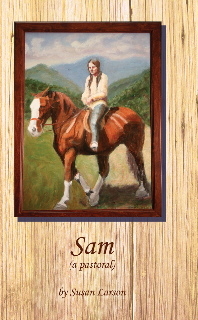My old hoss Sam, hero of his own book “Sam (a pastoral),” was broke and ridden The Old-Fashioned Way in his early life. Breaking a horse meant coercion and do-it-or-else: being hauled on, tied up, beat, cussed, hobbled, thrown, and other such stuff that has now fallen, thank heaven, out of fashion.
Sam did not take kindly to this; despite his common looks he was a sensitive horse, and a smart and generous one. How he would have enjoyed modern-day methods that didn’t exist when he was alive: like target training or clicker training, which make an amusing game out of learning. A horse is invited to figure out what his human wants, offers a behavior and then he gets paid for offering it. The horse gets really interested, because there’s something in it for him. Both the horse and the trainer get really good at reading one another, and there is no punishment or confusion involved for either party.
Confidence, calmness, happiness, and trust between human and animal increase rapidly. With this sort of training the horse can work at liberty. Over time, the horse follows you anywhere without a rope or strap on him, walks willingly into trailers, stands without being tied, does not mug you for food, waits at the gate for you instead of high-tailing it to the far corner of the paddock. No, he is already thinking about what he can do today to get paid some more. He will, in fact, learn to do just about anything you want or need, and have fun on the way.
I hope some of you saw the equine extravaganza “Cavalia” when it played around the country last year. Dozens of horses whizzing around the arena, most of them without a strap on them; they were all energetic but calm, focused on their people and doing the most amazing stuff. Don’t kid yourselves, they did their jobs and worked hard for the goodies, because there was something in it for them.
Some folks still get hostile about clicker training and other positive-reinforcement methods: it’s just bribing the horse, treating the horse, not subduing the horse to your will, they say. These folks don’t much care if there is anything in it for the animal or not, as long as they have ascendancy. I don’t want to have that relationship with an animal, or a human being either. Full disclosure: I got high-handed a few times with Ol’ Sam and blamed him and called him names and hauled him around; and he let me know firmly that my fits of temper and impatience were not going to get us anywhere. I felt sorry, I still feel sorry; remorse should count for something, right?
In the book, Sam and his child fumble around and mis-read each other at first, but they both do enough right things to forge a strong friendship. The kid figures out how her horse likes to be touched, and how to talk him down from his head-shyness, how to watch him for signs of his discomfort or mistrust. She manages get the horse on her side, to the point where he forgives her occasional lapses magnanimously. Considering that Sam was abused in his past life, and that he is big and strong enough to kill her and then eat her, or at least dump her in the grass and bolt for the barn, he is very nice to her.

